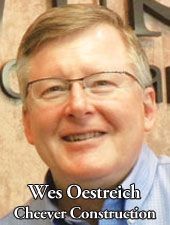As a steadily growing and flourishing business community turning the corner into much better weather conditions for construction, it is a healthy assumption that commercial projects will be a very popular undertaking in 2014. There are many reasons why you may be considering this type of project: you may have outgrown your office or the building that houses your business and you simply need more room, or a more functional space; maybe you are expanding to add an additional location; or you might even be starting out fresh and building from the ground up for the first time. Regardless of your unique goal for your office or business, there are plenty of highly accomplished and experienced professionals who can help you through each step of the process.
Finding a General Contractor for Your Project
While there will be many decisions you will make during your commercial construction endeavor, generally the first major decision you will make is finding a general contractor. This is a decision that is not to be taken lightly, as it is not only the first but the most important decision in terms of outlining and managing the entire project from start to finish. Not only will the general contractor be managing your project for you and handling all the other subcontractors and workers on and off the job; they also offer a wealth of information and great advice from their experience in the industry as well as their training and vast amount of working knowledge. This allows them to critically analyze everything about your project to come up with the best, and sometimes not the most obvious, solutions to keep your project moving on deadline and smoothly throughout each part of the process.
 Lund-Ross Constructors is a general contractor with 26 years of experience, who has done work on many types of commercial construction projects and is also well-known for historical renovations. They pride themselves on taking the most difficult and unique projects, and whether the job is $20,000 or $20 million, they like to think of each project as their only project. Scott Elley with Lund-Ross Constructors advises, “The best part about commercial construction is that our clients are proud of what they are doing, mainly their hard work and accomplishments, and we want to support that pride and nurture it when we partner with them to create their new space. Lund-Ross has always been, and will always be, a relationship-focused firm and our goal is to build a relationship and collaborate on a project instead of just building something for someone. We are personally involved with our clients and we are also actively involved in the communities where we do work. It’s not about the money and we don’t do ‘cookie cutter’ buildings; each individual client and their unique project are unlike any other. Many times big projects seem impersonal, but through our process of planning and negotiating we meet with our clients as many times as is necessary to reach a decision that they are excited about moving forward with.
Lund-Ross Constructors is a general contractor with 26 years of experience, who has done work on many types of commercial construction projects and is also well-known for historical renovations. They pride themselves on taking the most difficult and unique projects, and whether the job is $20,000 or $20 million, they like to think of each project as their only project. Scott Elley with Lund-Ross Constructors advises, “The best part about commercial construction is that our clients are proud of what they are doing, mainly their hard work and accomplishments, and we want to support that pride and nurture it when we partner with them to create their new space. Lund-Ross has always been, and will always be, a relationship-focused firm and our goal is to build a relationship and collaborate on a project instead of just building something for someone. We are personally involved with our clients and we are also actively involved in the communities where we do work. It’s not about the money and we don’t do ‘cookie cutter’ buildings; each individual client and their unique project are unlike any other. Many times big projects seem impersonal, but through our process of planning and negotiating we meet with our clients as many times as is necessary to reach a decision that they are excited about moving forward with.
My advice to anyone who is considering a commercial construction project is to first sit down and look at the whole project and what your goals are. You will want to fully consider and understand the scope of the project, how the building will be used and any special needs that are required. From an industrial warehouse to an office suite, each requires a specific understanding of site location and other various things that make the project unique. You will also need to think about what image you want your building to portray to your staff, clients and the community. There are many other things that you should consider on this topic and in the very beginning. How do you want to utilize the space? How much space do you want—and you may want to take an inventory of how much space you will actually need. What is the most important to you? Also, with respect to the professionals you will be working with, what type of communication do you prefer? Do you want constant contact, or do you just want the job to be done with minimal or no contact throughout the process? At Lund-Ross, we feel that it is SO important to understand all of the client’s needs because at the end of the day the finished product is a reflection of the client and it needs to say something about them.
You are then better able to decide whether you want bid work or negotiated work to be done. Selecting a construction project delivery method is another one of the most important decisions that an owner will make regarding a new building or renovation project. Bid work is where companies assess the project and everyone places a competitive bid with their ideas and cost accordingly, whereas negotiated work offers the opportunity for more meetings and/or conversations to work out ideas for the project before deciding on a price for the job as you only deal with one pre-selected contractor. This decision should be made early in the design phase of the project since it affects not only the contractual relationship between the owner and contractor, but also the scope of design services required for the project and as a result the relationship between the owner and the architect.
Either approach can yield successful results—a good product, delivered timely and at a fair price—and you must weigh the advantages and disadvantages before committing. It is very important, however, not to try to combine the two but rather to select one or the other and adhere to it for the entire project. If you choose to move forward with a negotiated project, you can address all of the questions and concepts you have initially brainstormed directly with them from the very beginning. If you opt for a bid situation with numerous general contractors bidding on the project, there will be varying estimates on the construction of the project and proposed ideas on their end about how the project can attain the highest level of success. It is important to remember in bid situations that the low bid doesn’t always equal the best contractor being awarded the project. A client should look for a balance between the cost of the project and the amenities as this will result in the best value for the client.”
Elley offers several suggestions for choosing a general contractor after all other factors have been assessed. “It is always best to first consider a list of contractors from the architectural firm they are working with on their project. The architects will have a feel for the contractors, the type of work they do, the ease of working with each, quality of construction, their ability to meet deadlines, and their history of bringing projects in on time while meeting the allotted budget. As I mentioned before, there are many types of projects within the world of commercial construction. For example, Lund-Ross specializes in historic renovations, schools, churches, multi-family, senior housing and non-profit projects. Finding a general contractor with as much knowledge and experience regarding the type of project you are undertaking is incredibly beneficial. Other things to consider besides their body of work are their years of experience in the industry, if they are on top of the latest construction methods and cutting-edge technology, and last but not least by any means, their safety records. We are proud to be one of the safest companies in Nebraska, and have six years under our belt without a reportable accident. All in all, we strive to earn the highest reputation among our clients, subcontractors, and community by providing superior construction services that result in the maximum value for our clients. We have only recently branched out with a new office in Lincoln, but since we arrived we have thoroughly enjoyed working in this community and are very proud of the projects we have completed.”
 Wes Oestreich with Cheever Construction adds that potential commercial property owners should always explore a contractor’s past project list and the level of satisfaction that their previous clients have had with that particular contractor. He says, “While looking into a general contractor who has experience with your specific type of project is helpful, you can’t go wrong with looking into contractors who will be able to cover all of your needs—effectively a ‘one-stop’ shop for your entire project. Cheever Construction is a one-call source for design as well as construction. As an integral part of the Design-Build team, we work together throughout the project to deliver quality control, schedule clarity and to minimize project risk for our clients. An advantage of the Design-Build strategy is that construction often begins before the final design is complete, which allows for a much shorter time frame while still giving you flexibility. Among our other Design-Build deliverables are budgeting, scheduling, project management and project closeout.
Wes Oestreich with Cheever Construction adds that potential commercial property owners should always explore a contractor’s past project list and the level of satisfaction that their previous clients have had with that particular contractor. He says, “While looking into a general contractor who has experience with your specific type of project is helpful, you can’t go wrong with looking into contractors who will be able to cover all of your needs—effectively a ‘one-stop’ shop for your entire project. Cheever Construction is a one-call source for design as well as construction. As an integral part of the Design-Build team, we work together throughout the project to deliver quality control, schedule clarity and to minimize project risk for our clients. An advantage of the Design-Build strategy is that construction often begins before the final design is complete, which allows for a much shorter time frame while still giving you flexibility. Among our other Design-Build deliverables are budgeting, scheduling, project management and project closeout.
As a commercial general contractor, Cheever Construction provides complete coordination of obtaining competitive bids from all trade sub-contractors, administering contracts and supervising all phases of construction. With our skilled employees, Cheever self-performs installation of concrete foundations, rough carpentry and finish carpentry installation of doors, hardware, cabinets, toilet partitions and many specialty items. As a full-service contractor we construct new buildings and also many levels of commercial renovation; from limited to extensive projects and in occupied or vacant buildings. Cheever Construction has a proven track record constructing many types of projects: schools, churches, office buildings, medical facilities, manufacturing, and senior living. We routinely complete small remodels to large multi-million dollar projects with a goal of client service.”
Oestreich advises, “One of the main pieces of advice I can offer is to ask for references, and then utilize those references by reviewing past examples of their successful work in addition to speaking with someone personally about their satisfaction and overall experience. You can also speak with your business peers about who has done their past work or which architects they have worked with, as your project will likely have similarities to theirs and not all commercial contractors have experience in every project type and job situation. I also really emphasize supporting your local-area builders. Lincoln has many excellent and capable commercial contractors who also utilize local area trade craftsmen and suppliers. This all helps to strengthen our local economy and makes Lincoln a quality community to live and raise families.”
As far as trending projects in Lincoln, he adds, “The local construction market has finally started to see some privately-funded projects move into construction mode although many projects continue to be public-funded, such as Lincoln Public Schools, University of Nebraska, City of Lincoln and other civic projects. Numerous renovation upgrades of local business and medical offices have been happening. Subsequently, every few years it is also important for business owners to ask themselves: ‘Is it time to freshen up our look?’”
Sustainability and efficiency, as well as a prime location, are at the top of the list of must-haves for today’s commercial clients according to Rick Krueger, owner of Krueger Development. He adds, “One thing that is notable about our developments in the Lincoln Trade Center, the Woodlands Enterprise Center, South Ridge Village, and the Yankee Hill Business Center is that location plays a major role in the planning of new commercial construction projects. South and east locations for commercial space have become very popular as residential areas are being developed in close proximity. My advice to prospective owners and occupants of commercial space is that now is the time to pursue ownership because of favorable interest rates as well as the availability of trade professionals and supplies. Growth areas of the city in the south and east are going to continue to present excellent opportunities for ownership, and that dynamic will continue to grow and flourish into the future.
 Randy Harre, owner of Schwisow Construction, also mentions that financing your project should be a main concern that is addressed in the initial planning for a commercial construction job. This will allow you to have an idea of what the budget for the project will look like prior to negotiating with the contractor or accepting any bids for the work. Harre notes, “The consensus among our colleagues, and currently in our industry, is that trying to get financing for commercial construction projects has become increasingly difficult in addition to meeting the ever-growing amount of government requirements and obtaining permits, meeting environmental and safety requirements, and all the other necessary things in place that slow down the process when not taken care of as soon as they should be. It is important that you don’t place unrealistic expectations on your builder due to the timeline of the project being moved up or slowed in other areas. For example, an owner may plan mentally for a commercial construction project for months and work on it in house as well before releasing this information, so by the time this happens they have reached the end of their process and they are just ready to ‘get it done.’ This puts a great deal of pressure on industry professionals to meet unrealistic completion dates—sometimes this includes less time to actually build the structure than to obtain financing or be drawn out by an engineer or architect. When an owner has everything in order and has already formed a working relationship with a financial institution for the project, it is much easier to get the ball rolling to get qualified for funding in a reasonable amount of time without delaying another part of the whole process. The same is true for solidifying the design and engineering; the sooner the better. A lot of times we will strike an agreement with our clients to complete partial drawings in order to get to a point where we can give them a qualified and fairly complete estimate that they can use for banking purposes. It is hard to go to the banker more than once, and we want our clients to be prepared for their initial meeting if not the next one after they have formed a relationship with their financial institution and representative of choice. Furthermore, we do this just for the opportunity to work with the client and no strings are attached. At the point that the client feels confident that the project is going forward, we then release the preliminary design for completion. This gives the client a chance to get a few other bids in order to price-check us, and also provides for the chance for our company to re-bid if we feel that we missed the mark. That way we can ensure that both our company and the client have received a fair deal across the board. It really is the best of both worlds because we find that this process advances the engineering and time frame of the project but also lets the client do their homework and feel comfortable that we were right there with our numbers.
Randy Harre, owner of Schwisow Construction, also mentions that financing your project should be a main concern that is addressed in the initial planning for a commercial construction job. This will allow you to have an idea of what the budget for the project will look like prior to negotiating with the contractor or accepting any bids for the work. Harre notes, “The consensus among our colleagues, and currently in our industry, is that trying to get financing for commercial construction projects has become increasingly difficult in addition to meeting the ever-growing amount of government requirements and obtaining permits, meeting environmental and safety requirements, and all the other necessary things in place that slow down the process when not taken care of as soon as they should be. It is important that you don’t place unrealistic expectations on your builder due to the timeline of the project being moved up or slowed in other areas. For example, an owner may plan mentally for a commercial construction project for months and work on it in house as well before releasing this information, so by the time this happens they have reached the end of their process and they are just ready to ‘get it done.’ This puts a great deal of pressure on industry professionals to meet unrealistic completion dates—sometimes this includes less time to actually build the structure than to obtain financing or be drawn out by an engineer or architect. When an owner has everything in order and has already formed a working relationship with a financial institution for the project, it is much easier to get the ball rolling to get qualified for funding in a reasonable amount of time without delaying another part of the whole process. The same is true for solidifying the design and engineering; the sooner the better. A lot of times we will strike an agreement with our clients to complete partial drawings in order to get to a point where we can give them a qualified and fairly complete estimate that they can use for banking purposes. It is hard to go to the banker more than once, and we want our clients to be prepared for their initial meeting if not the next one after they have formed a relationship with their financial institution and representative of choice. Furthermore, we do this just for the opportunity to work with the client and no strings are attached. At the point that the client feels confident that the project is going forward, we then release the preliminary design for completion. This gives the client a chance to get a few other bids in order to price-check us, and also provides for the chance for our company to re-bid if we feel that we missed the mark. That way we can ensure that both our company and the client have received a fair deal across the board. It really is the best of both worlds because we find that this process advances the engineering and time frame of the project but also lets the client do their homework and feel comfortable that we were right there with our numbers.
At Schwisow Construction, we not only place an emphasis on quality work and customer service, but we also strive to solidify plans and eliminate unknowns before the cost spirals out of control. For example, if we find out the soil is bad or the location is in a flood plain, or even if there is a special electrical requirement that can’t be facilitated without some huge fee incurred, our clients are the first to know and we are proactive about finding a resolution. We also utilize the building process to educate our clients each step of the way. The most important part of this education is an awareness of how this type of purchase differs greatly from other purchases. People are used to buying commodities, so if you are buying a Chevy truck for example, you can go to ten stores and find the same make and model of truck. You can’t do this with construction; no matter how high quality your materials are they are no better than the builder who constructs with them and every project is different. Regardless of the fact that you are building the same structure or using the same design, other factors such as the site will always vary to a certain degree. Taking into account all of the parts that work together to create a whole is the best way to approach a commercial construction project, and planning ahead will ensure your project is successful.”
Installing and Controlling Your Building’s Systems
New buildings require new wiring, among other features that will need to be installed by a qualified and certified electrician. Whether this is a decision made by the general contractor or by the business owner, it is not a decision that should be made hastily either as not just any electrician will be a good fit for every type and size of project. Your electrician will also play a very important role in the functioning of the finished project and the overall safety of your building.
 Eric Hoke, owner of Eric’s Electric, emphasizes that before doing any electrical work or making a final decision on which company you will hire, make sure to consider the following points:
Eric Hoke, owner of Eric’s Electric, emphasizes that before doing any electrical work or making a final decision on which company you will hire, make sure to consider the following points:
“Your electrician, along with the other professionals managing and working on the project, should be aware of the required electrical permits, inspections and approval necessary as required by law and should also have an understanding of obtaining them in unison with the project timeline. These are crucial for protecting your investment. According to the National Fire Protection Association, about 13,200 fires caused by electrical wiring are reported each year resulting in 20 deaths, 250 injuries, and $399 million in commercial property damage. You could also be subject to civil penalties if you do not obtain the required permits. These fines also compound daily until a permit is obtained, and additional penalties can be levied for failing to correct any violations noted during an electrical inspection. Furthermore, your electrical power might be disconnected if you fail to comply with the law. An electrical permit must be purchased by the company doing the work. Only property owners or electrical contractors can purchase an electrical permit. The lack of a permit, inspection and approval could affect the safety of your business, as well as your ability to obtain financing, sell your property, obtain insurance or collect on insurance claims. Following the proper steps will ensure that the work done on your property conforms to current safety codes as well. Not only is an electrical permit required for most new buildings, it may also be required for remodels and even maintenance work and is required for common office necessities such as thermostats, intercoms, security and fire alarm systems, generators, telecommunication systems, audio-visual systems and even septic systems. Furthermore, ensuring that all electrical equipment is built to an appropriate electrical standard is a key component in the inspection process and should be evaluated by a professional as well.
I urge anyone considering involvement in the execution of projects with an electrical element to have any work done by someone who is qualified to do so. If you do not have a good understanding of electrical wiring and are not qualified to perform this type of work, hire a licensed electrical contractor! When planning for a commercial build, you will be able to design and plan for your electrical system needs. Make sure that you plan for enough outlets to accommodate your employees and the necessary technology so as to never overload outlets, extension cords or electrical circuits. If you hire an electrical contractor, make sure he or she is properly licensed. When checking the contractor’s license, make sure to take notice of any past violations. Also, make sure to get a written quote for all the work to be done if it is not involved with the quote from the general contractor in the case that they are managing other trade professionals. Our principles, as well as the principles that guide state electrical inspections, are public safety (to protect the general public from unsafe living or working conditions), fire safety (improperly installed components, including electrical, are the leading cause of fires), and consumer protection (improperly installed electrical work can be costly to a property owner).”
 Ensuring that your new commercial property has the necessary fire and safety equipment and complies with all laws, codes and OSHA requirements is of the utmost importance. You are not only protecting your investment in the property, you are protecting the lives of your employees and clients. Since 1964, General Fire & Safety Equipment Company has been committed to the proper installation and flawless execution of fire alarm systems, fire suppression systems, fire extinguisher service and a wide variety of safety and security equipment. RJ Lipert of General Fire & Safety advises, “Because the lives and assets of our clients are at stake, we take our job very seriously. We not only strive to provide the best equipment in the industry, but our technicians also play a big role in commercial construction projects by not only installing the equipment properly but by educating the client on the most effective and reliable ways to protect their new facility during the planning and construction phases. No matter how big or small your building will be, and no matter what type of industry you are in, our goal is to put the right systems in place so that your property is safe and protected. You can also visit our website, www.generalfiresafety.com, to check out the extensive list of safety equipment we have to offer.”
Ensuring that your new commercial property has the necessary fire and safety equipment and complies with all laws, codes and OSHA requirements is of the utmost importance. You are not only protecting your investment in the property, you are protecting the lives of your employees and clients. Since 1964, General Fire & Safety Equipment Company has been committed to the proper installation and flawless execution of fire alarm systems, fire suppression systems, fire extinguisher service and a wide variety of safety and security equipment. RJ Lipert of General Fire & Safety advises, “Because the lives and assets of our clients are at stake, we take our job very seriously. We not only strive to provide the best equipment in the industry, but our technicians also play a big role in commercial construction projects by not only installing the equipment properly but by educating the client on the most effective and reliable ways to protect their new facility during the planning and construction phases. No matter how big or small your building will be, and no matter what type of industry you are in, our goal is to put the right systems in place so that your property is safe and protected. You can also visit our website, www.generalfiresafety.com, to check out the extensive list of safety equipment we have to offer.”
Integrated Controls provides a wide variety of products designed for complete building automation systems. Their products and services can be tailored to fit the needs of every commercial project out there; regardless of size or budget. This includes complete temperature control systems, but they also combine security, card access and video controls, and make them all accessible from the same web-based front end.
 Regarding their experience with commercial construction projects, Hannah Ahlstedt of Integrated Controls advises, “It’s always better to do something right the first time. Building owners don’t want to be in a position where they have to replace a temperature control system every 5 years in because it’s not controlling the way they need it to. Once construction is finished, the building automation system will be the owner’s point of contact for controlling not only their HVAC controls, but possibly their security, card access and lighting controls as well. If a system is installed correctly, with quality products, the controls should not only keep the building safe and comfortable, but should also extend the life of the equipment and keep operating costs and energy usage as low as possible. My advice would be to talk with us before the construction process is started. We take pride in really assessing our clients’ needs, and customizing their building automation system to fit them exactly. Often times this will also save the client money, as well as saving them from headache down the road. One of the biggest trends in the building automation industry is the ability to become mobile friendly. Besides just being web-based, our systems have helpful mobile apps for our clients to view their system graphics, as well as schedule, alarm, and trend their building.”
Regarding their experience with commercial construction projects, Hannah Ahlstedt of Integrated Controls advises, “It’s always better to do something right the first time. Building owners don’t want to be in a position where they have to replace a temperature control system every 5 years in because it’s not controlling the way they need it to. Once construction is finished, the building automation system will be the owner’s point of contact for controlling not only their HVAC controls, but possibly their security, card access and lighting controls as well. If a system is installed correctly, with quality products, the controls should not only keep the building safe and comfortable, but should also extend the life of the equipment and keep operating costs and energy usage as low as possible. My advice would be to talk with us before the construction process is started. We take pride in really assessing our clients’ needs, and customizing their building automation system to fit them exactly. Often times this will also save the client money, as well as saving them from headache down the road. One of the biggest trends in the building automation industry is the ability to become mobile friendly. Besides just being web-based, our systems have helpful mobile apps for our clients to view their system graphics, as well as schedule, alarm, and trend their building.”
 Jon Eicher, Project Manager for ABC Electric, emphasizes the great importance of electricians in commercial jobs. “For commercial construction projects, ABC Electric can help in the building design and accurate cost estimates for the electrical portion of the project. This also helps in making sure the specific electrical requirements or special requests of the owner are being filled with the most economical options available. Recently, the popularity of LED lighting and control systems has grown immensely, and knowing which product to use and how to control its features are a necessity. Fortunately we have become very proficient at providing this service.” He adds, “Our first word of advice is to hire professionals for each portion of the construction process. Initial low cost contractors do not typically offer a value-added end product. A trend we see happening in the commercial construction industry is the use of energy efficient LED lighting and energy controls. This technology is always evolving and staying current on its trends, and intricacies, is vital. I also urge anyone considering this type of project to hire professionals who take pride in their vocation. Furthermore, I always stress the significance of developing a realistic project budget. If you are willing to spend a little more money up front, you will definitely reap the benefits of energy efficient systems in the following years.”
Jon Eicher, Project Manager for ABC Electric, emphasizes the great importance of electricians in commercial jobs. “For commercial construction projects, ABC Electric can help in the building design and accurate cost estimates for the electrical portion of the project. This also helps in making sure the specific electrical requirements or special requests of the owner are being filled with the most economical options available. Recently, the popularity of LED lighting and control systems has grown immensely, and knowing which product to use and how to control its features are a necessity. Fortunately we have become very proficient at providing this service.” He adds, “Our first word of advice is to hire professionals for each portion of the construction process. Initial low cost contractors do not typically offer a value-added end product. A trend we see happening in the commercial construction industry is the use of energy efficient LED lighting and energy controls. This technology is always evolving and staying current on its trends, and intricacies, is vital. I also urge anyone considering this type of project to hire professionals who take pride in their vocation. Furthermore, I always stress the significance of developing a realistic project budget. If you are willing to spend a little more money up front, you will definitely reap the benefits of energy efficient systems in the following years.”
 Energy efficiency is becoming a huge asset for businesses who are managing their costs while making a name for themselves as a company or business who values doing the right thing for the environment. In addition to your general contractor, your electrician will know exactly what is trending and what will serve your new property the best while saving you the most money. Another important thing to consider is controlling your building’s systems, and there are professionals available who specialize in this alone and who will also work closely with you to manage your building once it is completed. Pat Killeen of Engineered Controls states, “Engineered Controls can provide building control technology that plays a big role in assisting commercial buildings (and homes) in monitoring, measuring and controlling energy costs, while still maintaining comfortable building environments. Taking into account that lighting and HVAC (heating, ventilation, and air conditioning) accounts for nearly 80% of a building’s energy usage you want to make sure you are maximizing the energy options available. Engineered Controls can provide lighting control systems that automatically adjust the electrical output to lighting fixtures based on the amount of natural daylight a building might have. ECI can monitor and control energy usage of heating and cooling (both air and water distribution) loads in order to maintain a desired level of energy usage and still maintain a comfortable building environment.
Energy efficiency is becoming a huge asset for businesses who are managing their costs while making a name for themselves as a company or business who values doing the right thing for the environment. In addition to your general contractor, your electrician will know exactly what is trending and what will serve your new property the best while saving you the most money. Another important thing to consider is controlling your building’s systems, and there are professionals available who specialize in this alone and who will also work closely with you to manage your building once it is completed. Pat Killeen of Engineered Controls states, “Engineered Controls can provide building control technology that plays a big role in assisting commercial buildings (and homes) in monitoring, measuring and controlling energy costs, while still maintaining comfortable building environments. Taking into account that lighting and HVAC (heating, ventilation, and air conditioning) accounts for nearly 80% of a building’s energy usage you want to make sure you are maximizing the energy options available. Engineered Controls can provide lighting control systems that automatically adjust the electrical output to lighting fixtures based on the amount of natural daylight a building might have. ECI can monitor and control energy usage of heating and cooling (both air and water distribution) loads in order to maintain a desired level of energy usage and still maintain a comfortable building environment.
Some common critical building systems are heating and cooling systems, data room environment systems, lighting systems, access control systems, security/surveillance systems, backup power systems, and fire alarm systems. While each of these systems can stand alone, integrating the systems that complement each other can reap benefits of a more efficient energy usage while still maintaining a safe and comfortable working environment.”
Considering an Offsite Data Storage Center
Technology is advancing in leaps and bounds and commercial entities are realizing the many benefits of going paperless with respect to keeping their important information and records safe and secure. Though this transition has a distinct learning curve and requires a shift from traditional filling and records management, it allows for a wide range of capabilities that help businesses function at an optimal level. There is also more of an emphasis on physically accommodating the equipment necessary for your data storage and thus, planning for whether to house this storage set-up on-site or off-site. Commercial construction projects in this day and age should definitely take into consideration the information technology needs of the client during the planning phase.
 Roger Willey, Vice President of Sales & Marketing for the Nebraska Colocation Centers, explains, “Businesses are becoming more dependent on real-time access to data and information in order to perform traditional operating functions. Computer networks host applications that allow companies to execute tasks such as servicing and invoicing a customer, managing inventory, fulfilling an order and generating automated performance reports. Most businesses simply won’t operate, or will be severely limited, if their technology infrastructure fails. Yet, the data center needs are many times left out in the planning and budgeting for commercial construction projects.”
Roger Willey, Vice President of Sales & Marketing for the Nebraska Colocation Centers, explains, “Businesses are becoming more dependent on real-time access to data and information in order to perform traditional operating functions. Computer networks host applications that allow companies to execute tasks such as servicing and invoicing a customer, managing inventory, fulfilling an order and generating automated performance reports. Most businesses simply won’t operate, or will be severely limited, if their technology infrastructure fails. Yet, the data center needs are many times left out in the planning and budgeting for commercial construction projects.”
With more data being collected and stored, as well as increased regulatory requirements for storage of that data, security has become a larger concern to businesses. Any business that collects and stores private data needs to carefully consider how to secure access to their network as they plan for their data center environment.
To effectively design for data center space within your commercial building, consider these factors:
• How much space will be needed for computer equipment within the next 3, 5 and 10 years?
• How much power will be required to support the equipment within the next 3, 5 and 10 years?
• What options should be implemented for backup/emergency power? Are UPS systems viable or should you consider an investment in diesel generator in the case of an extended power outage?
• How much cooling capacity will be need to maintain optimum temperatures and atmospherics that will provide extended life of equipment?
• How do you restrict access to the data center to protect equipment, sensitive customer data and intellectual property of the business?
If this sounds like more than you want to consider, you aren’t alone. According to a recent report by DCD Intelligence, nearly 25% of all data center space in North America is outsourced to a colocation center. That number is up by 13% over the past 12 months and is expected to increase another 15% in 2014.
“Most of our customers understand that the reliability and security of their network is critical to the existence of their business,” Willey adds. “When you consider the cost to build, maintain, and monitor a data center, there is a strong business case for outsourcing.”
Businesses that choose a colocation center over building their own data center have other decided advantages. Besides more space utilized for staff and operations, building owners have lower capital investment in the property without having to pay for expensive technology infrastructure. “Implementing redundant power, cooling and security measures are expensive”, says Willey. “A facility like ours offers an opportunity to get the redundant power, cooling and security features while paying a reasonable monthly fee”.
Whether you build or outsource, don’t overlook the importance of planning for technology in your next commercial project.
Material Storage and Disposal – Before, During and After a Commercial Construction Project
 You will likely experience a time of transition during your commercial construction project where things are getting moved around like crazy. Items may be arriving for your new space before it is ready to house them, you may need to move old items to a different location while you are trying to get rid of them or repurpose them, or you might just need somewhere safe to keep a few things that you don’t know if you will need or use yet. During this time, it may be a good idea to utilize a storage facility so that your important and expensive items are safe from damage or theft and in one place where they can be easily located. Tom Friedman of Strong Box Storage says, “Often times we assist our commercial clients by providing space to store items that they don’t want onsite immediately, whether it is materials for construction or items for the space once it is completed. Also, many commercial builders store their materials, tools and equipment for projects in order to avoid theft or damage on a job site. We work with all types of clients with diverse sets of needs and requirements.
You will likely experience a time of transition during your commercial construction project where things are getting moved around like crazy. Items may be arriving for your new space before it is ready to house them, you may need to move old items to a different location while you are trying to get rid of them or repurpose them, or you might just need somewhere safe to keep a few things that you don’t know if you will need or use yet. During this time, it may be a good idea to utilize a storage facility so that your important and expensive items are safe from damage or theft and in one place where they can be easily located. Tom Friedman of Strong Box Storage says, “Often times we assist our commercial clients by providing space to store items that they don’t want onsite immediately, whether it is materials for construction or items for the space once it is completed. Also, many commercial builders store their materials, tools and equipment for projects in order to avoid theft or damage on a job site. We work with all types of clients with diverse sets of needs and requirements.
We have many different sizes of units, and each employee or individual who needs access to the unit is provided with a separate access code in order to track exactly who was in and out and at what times. We are a secured facility and can set up a unit for a customer onsite without any prior notification, or we can schedule a unit to be available for future dates. As far as payment, we are very flexible. We take all forms of payment–cash, check, and personal or company cards–and you can pay at our facility or online. You can also set up payment for a lump sum or payments on a monthly, quarterly, or yearly basis. Another one of our features that offers flexibility and is popular among our commercial clients is 24/7 access. Our facility offers lighted and paved roadways to make it easy and safe to get around, and if there are any problems we have staff on site six days a week. You can access your unit at whatever time is most convenient for you with no hassle, and we also have U-Haul trucks for rent if you need to move items to and from our facility and you don’t have access to an appropriate vehicle.”
 If you need waste disposal at the construction site, Niederhaus Refuse offers roll-off boxes that are very popular among contractors and make it relatively easy to transport and dispose of excess waste and materials. These roll-offs are available in several sizes, ranging from 15-30 cubic yards, which work well for just about any size project. They also offer rear load containers that you can just roll up to the site, fill up, and then call for the container to be picked up and hauled away for disposal. Niederhaus Refuse owner Scott Niederhaus adds, “There are many benefits of roll-offs, but it is mainly a convenient way to dispose of waste in a timely fashion, that would otherwise clutter a project site. Based upon the customer’s needs and how eco-friendly they would like to be, we also offer to recycle materials that would otherwise be disposed of and take up space in our local landfills. Although this requires a larger sized box, it is something that is good for our community and good for the environment. One thing is for sure about any construction project—there is always waste to get rid of. Our roll-off and rear-load containers make everyone’s job easier.”
If you need waste disposal at the construction site, Niederhaus Refuse offers roll-off boxes that are very popular among contractors and make it relatively easy to transport and dispose of excess waste and materials. These roll-offs are available in several sizes, ranging from 15-30 cubic yards, which work well for just about any size project. They also offer rear load containers that you can just roll up to the site, fill up, and then call for the container to be picked up and hauled away for disposal. Niederhaus Refuse owner Scott Niederhaus adds, “There are many benefits of roll-offs, but it is mainly a convenient way to dispose of waste in a timely fashion, that would otherwise clutter a project site. Based upon the customer’s needs and how eco-friendly they would like to be, we also offer to recycle materials that would otherwise be disposed of and take up space in our local landfills. Although this requires a larger sized box, it is something that is good for our community and good for the environment. One thing is for sure about any construction project—there is always waste to get rid of. Our roll-off and rear-load containers make everyone’s job easier.”
Financing Your Commercial Construction Project
 Brian Wolford, Lincoln Market President of Midwest Bank, offers the following tips regarding obtaining financing for commercial construction projects:
Brian Wolford, Lincoln Market President of Midwest Bank, offers the following tips regarding obtaining financing for commercial construction projects:
“At Midwest Bank, we work with our customers as a financial partner. Whether the commercial construction project is small or large it requires significant attention to detail on behalf of the borrower and the bank. Midwest Bank assists those who are taking on a construction project by providing custom financing options that save clients time and money, by protecting borrowers through risk management services and by responding quickly to draw requests to keep the project on schedule.
Each commercial construction project is unique. We carefully listen to our clients to understand the expected construction time frame, the lease-up phase and the stabilization period. Once we understand these important factors, we can build a custom loan product that fits our clients’ needs. A popular product for commercial construction loan borrowers is the mini-perm loan. Combining the short term construction loan and the longer term permanent loan into one mini-perm loan with one loan closing simplifies the process and saves the borrower time and money.
Midwest Bank provides risk management throughout the commercial construction project to protect our borrowers. Risks are identified before the project begins by investigating environmental risks, zoning and easement threats and even potential tax implications. Our job is to help identify and mitigate those risks. Detailed budget monitoring during construction is a popular service that we provide. This helps keep the borrower apprised of actual construction costs compared to budgeted costs during the project. Interest rate fluctuation during the project is another risk that can be addressed and mitigated.
Professional inspections and timely draw requests help keep the project on schedule and can prevent possible construction liens. When a draw request is made, we understand that time is of the essence. It’s important to have a professional immediately available to conduct the inspection and a good title company to collect lien waivers and issue payments to contractors. This process needs to be done correctly to protect all parties from risk and quickly to keep the project on schedule.
He adds, “There are three tips I would give to someone financing a commercial construction endeavor. The first tip is to get your key players together to discuss the project before you begin. It’s good to make sure the contractor, architect and banker communicate with one another so the project goes as planned. Secondly, make certain your project costs are accurate and it is clearly understood how potential cost overruns will be handled. Finally, it is important to investigate permanent financing options.
One popular trend in the Lincoln market is the utilization of the Small Business Administration (SBA) 504 loan program for permanent financing. The program encourages business owners to invest in fixed assets by working with the bank to provide permanent financing for the commercial project. A 10% minimum down payment is required, followed by a 50% bank loan in a first lien position. The SBA provides the remaining 40% loan in a second lien position. Borrowers are attracted to this program because of the lower down payment requirements and a longer, fixed interest rate on the SBA loan. The 50% loan to value is attractive to banks. For owner occupied commercial properties, the SBA 504 loan should be considered.
Interest rates continue to be low and make this a good time to consider a commercial construction project. At Midwest Bank, we can answer questions about construction and permanent financing and can build a loan product to meet your needs. We will help identify and mitigate project risks and finally, we provide professional inspections and timely draw requests to help keep the project on schedule. For questions about commercial construction financing, please contact me personally at (402) 420-0560.”
Interior and Exterior Design Features of Your Commercial Space – Presentation is Key
How your commercial property looks is largely just as important as how it functions, as you want it to make a positive impression on your clients and the community.
 JL Exteriors provides a great deal of experience and craftsmanship when designing, fabricating and installing the exterior features on properties of all types and sizes. Lance Roach, owner of JL Exteriors, advises, “When all exterior features of your property are considered, the actual building itself will likely be a major focal point. I always advise my clients to never underestimate how the right siding will transform the appearance of the building itself. There are plenty of siding choices you can make for a unique or signature look, including stucco, stone, fiber cement, vinyl and steel. The siding materials should not only be chosen by appearance, but also by the desired function. Another exterior feature that you may want to consider for a commercial property is an outdoor structure such as a deck, patio or porch. These are great for entertaining clients and guests or for a nice employee break space, and there is a great deal of flexibility in how they can be built in order to achieve both the look and function you desire. They are not only a nice amenity, but an excellent selling point and a feature that will increase the value of your property. Other exterior factors you will be considering are doors, windows, roofing and gutters—and we can do it all. For those who will be taking on a commercial construction project, I highly recommend doing your research on what is available as far as products and companies who are capable of doing the jobs you require. Always look at longevity and durability—what’s going to last the longest that requires minimal maintenance and will generally give you the best bang for your buck without sacrificing quality and workmanship.”
JL Exteriors provides a great deal of experience and craftsmanship when designing, fabricating and installing the exterior features on properties of all types and sizes. Lance Roach, owner of JL Exteriors, advises, “When all exterior features of your property are considered, the actual building itself will likely be a major focal point. I always advise my clients to never underestimate how the right siding will transform the appearance of the building itself. There are plenty of siding choices you can make for a unique or signature look, including stucco, stone, fiber cement, vinyl and steel. The siding materials should not only be chosen by appearance, but also by the desired function. Another exterior feature that you may want to consider for a commercial property is an outdoor structure such as a deck, patio or porch. These are great for entertaining clients and guests or for a nice employee break space, and there is a great deal of flexibility in how they can be built in order to achieve both the look and function you desire. They are not only a nice amenity, but an excellent selling point and a feature that will increase the value of your property. Other exterior factors you will be considering are doors, windows, roofing and gutters—and we can do it all. For those who will be taking on a commercial construction project, I highly recommend doing your research on what is available as far as products and companies who are capable of doing the jobs you require. Always look at longevity and durability—what’s going to last the longest that requires minimal maintenance and will generally give you the best bang for your buck without sacrificing quality and workmanship.”
Utilizing Landscaping to Enhance Curb Appeal
One major thing with respect to the exterior features of your property is the landscaping. This should be taken into to account in the initial phase of planning for your commercial construction project.
 Ken Svoboda, owner of Ray’s Lawn Care, says, “The entrance to your property, surrounding features, and their collective ‘curb-appeal’ will influence and shape your customer or client’s first impression of your business. Many of our commercial clients request low maintenance landscapes that still have a great deal of color and texture throughout. This goal is well within reach and offers a wealth of possibilities—you would be surprised how many beautiful plants, trees and grasses require very minimal maintenance to sustain them and are perfect for Nebraska’s unique climate. It is finding the right ones that is key to a successful commercial landscaping endeavor. After a building is constructed, it will take a little bit of time to get the landscape set and to see growth from the point of being planted until it has settled and matured. However, in this situation you have a great deal of freedom because you are starting with a clean slate. We’re also finding that more commercial clients are interested in finishing touches such as pondless water features and outdoor areas for employees to sit and relax in some shade with some privacy as well. These are features that can easily be added into a commercial construction project without busting the budget in addition to adding a great deal of interest and pride. If there’s one piece of advice that I would extend to commercial property managers or owners, it is to include a landscape designer in the initial stages of the project review. Colors, textures and themes can be incorporated in the exterior landscaping that will provide a nice flow from outside to inside.” He adds, “When considering what your landscape will look like from post-construction and well into the future, the number one thing to remember is to plan appropriately for the growth of plants. You’d be surprised how often we are asked to review a commercial property where trees were planted so close to the building that an entire half the tree had been pruned to keep from damaging the siding. Or shrub roses that were planted too close to a sidewalk and when fully grown, would grab at every silk skirt that walked by. Simple is better when it comes to commercial landscape design. Too many plantings can be a hiding place for those wanting to break into the building or jump an employee. The landscape should also be a reflection of the business. For example, a financial facility should show a firm yet financially prudent landscape with mature trees and a well-managed appearance. On the other hand, a retail operation might consider a whimsical landscape with sculptures, a variety of bright vibrant colors and grasses that bend and flow with the wind. The best service we can offer our commercial clients is peace of mind that nothing will be overlooked or neglected, in addition to giving your property a ‘wow’ factor. As a consultant, we give the client a second set of eyes as to what others will see in their property.”
Ken Svoboda, owner of Ray’s Lawn Care, says, “The entrance to your property, surrounding features, and their collective ‘curb-appeal’ will influence and shape your customer or client’s first impression of your business. Many of our commercial clients request low maintenance landscapes that still have a great deal of color and texture throughout. This goal is well within reach and offers a wealth of possibilities—you would be surprised how many beautiful plants, trees and grasses require very minimal maintenance to sustain them and are perfect for Nebraska’s unique climate. It is finding the right ones that is key to a successful commercial landscaping endeavor. After a building is constructed, it will take a little bit of time to get the landscape set and to see growth from the point of being planted until it has settled and matured. However, in this situation you have a great deal of freedom because you are starting with a clean slate. We’re also finding that more commercial clients are interested in finishing touches such as pondless water features and outdoor areas for employees to sit and relax in some shade with some privacy as well. These are features that can easily be added into a commercial construction project without busting the budget in addition to adding a great deal of interest and pride. If there’s one piece of advice that I would extend to commercial property managers or owners, it is to include a landscape designer in the initial stages of the project review. Colors, textures and themes can be incorporated in the exterior landscaping that will provide a nice flow from outside to inside.” He adds, “When considering what your landscape will look like from post-construction and well into the future, the number one thing to remember is to plan appropriately for the growth of plants. You’d be surprised how often we are asked to review a commercial property where trees were planted so close to the building that an entire half the tree had been pruned to keep from damaging the siding. Or shrub roses that were planted too close to a sidewalk and when fully grown, would grab at every silk skirt that walked by. Simple is better when it comes to commercial landscape design. Too many plantings can be a hiding place for those wanting to break into the building or jump an employee. The landscape should also be a reflection of the business. For example, a financial facility should show a firm yet financially prudent landscape with mature trees and a well-managed appearance. On the other hand, a retail operation might consider a whimsical landscape with sculptures, a variety of bright vibrant colors and grasses that bend and flow with the wind. The best service we can offer our commercial clients is peace of mind that nothing will be overlooked or neglected, in addition to giving your property a ‘wow’ factor. As a consultant, we give the client a second set of eyes as to what others will see in their property.”

New Horizon Landscaping is a complete landscaping company, and we work with our clients from concept to the finished product. At New Horizon Landscaping we pride ourselves in being committed to providing excellent service by knowledgeable informed professionals at a competitive price. We want to consistently exceed each customer’s expectations while setting the green industry standard for quality craftsmanship and professionalism. Our services include professional landscape design, full installation, landscape plant and bed maintenance, water feature design and installation, grading, drainage implementation and correction, consultation services, and erosion control installation and planning. Each of our project managers has a minimum of six years working in the field and/or a degree in horticulture. Not only do we have the experience; we all agree that our work is a labor of love and we take pride in that. We provide free estimates and are happy to meet with you to discuss the specifics and your vision for the landscape of your commercial property.”
 David Hastreiter of Pro-Scapes agrees that landscape design is a very important aspect to the exterior of a commercial property. “Landscape design focuses on both the integrated master landscape planning of a property and the specific garden design of the landscape elements and plants within it. The practical, aesthetic, horticultural, and environmental sustainability components certainly merit landscape design inclusion on any major construction project. In fact, landscape designers often collaborate with related disciplines such as architecture, soils and civil engineering, surveying, landscape contracting, botany, and even artisan specialties. Factors in designing include objective qualities; such as the climate and microclimates, topography and orientation, site drainage and groundwater recharge, municipal and resource building codes, soils and irrigation, human and vehicular access and circulation, recreational amenities, furnishings and lighting, native plant habitat botany when present, property safety and security, construction detailing and other measurable considerations. Factors in designing also include subjective qualities such as genius loci (special site qualities to emphasize), the client’s needs and preferences, desirable plants and elements to retain on-site as well as those you want to modify or replace, artistic composition from different perspectives (inside the property vs. an onlooker or passerby), spatial development and definition, plant palettes in designed layouts, and artistic focal points for enjoyment. I highly recommend working with an experienced professional when it comes to landscaping, as there are an infinite number design factors and considerations brought to into the complex process of designing a property landscape that is beautiful, well-functioning, and thrives over time.”
David Hastreiter of Pro-Scapes agrees that landscape design is a very important aspect to the exterior of a commercial property. “Landscape design focuses on both the integrated master landscape planning of a property and the specific garden design of the landscape elements and plants within it. The practical, aesthetic, horticultural, and environmental sustainability components certainly merit landscape design inclusion on any major construction project. In fact, landscape designers often collaborate with related disciplines such as architecture, soils and civil engineering, surveying, landscape contracting, botany, and even artisan specialties. Factors in designing include objective qualities; such as the climate and microclimates, topography and orientation, site drainage and groundwater recharge, municipal and resource building codes, soils and irrigation, human and vehicular access and circulation, recreational amenities, furnishings and lighting, native plant habitat botany when present, property safety and security, construction detailing and other measurable considerations. Factors in designing also include subjective qualities such as genius loci (special site qualities to emphasize), the client’s needs and preferences, desirable plants and elements to retain on-site as well as those you want to modify or replace, artistic composition from different perspectives (inside the property vs. an onlooker or passerby), spatial development and definition, plant palettes in designed layouts, and artistic focal points for enjoyment. I highly recommend working with an experienced professional when it comes to landscaping, as there are an infinite number design factors and considerations brought to into the complex process of designing a property landscape that is beautiful, well-functioning, and thrives over time.”
The Importance of Irrigation for Commercial Properties
 According to Jeremy Hunt, owner of Hunt Irrigation:
According to Jeremy Hunt, owner of Hunt Irrigation:
“Commercial properties often possess a series of features that are in need of regular watering. Lawns, landscaped beds, trees, shrubs and soil create a pleasing look and good first impression to visitors, and all of these features need water to thrive. Irrigation systems are easily the most efficient tools available to meet the watering needs of various plant life while serving to keep the soil fertile and healthy. Irrigation systems also aid in water conservation when scheduled properly, and can ultimately save an organization money from expensive lawn repair, sodding and soil needs that arise due to neglect and drought-like conditions. Irrigation systems can also be managed and scheduled to adhere to any legal stipulations put in place due to a drought or natural disaster.
The most important part of the design process is understanding your watering window or the amount of time your system will need to operate in order to sufficiently cover all the different aspects of your commercial project’s lawn and landscape. The water service size and water pressure greatly affect the total area that can be irrigated within an 8 hour window. On a commercial project we do not want the system to operate during business hours, generally we would like to have the system operate between midnight or 1am and ending at 6am. This ensures that there is no cross-over traffic between the irrigation system and your clients or employees. Your irrigation contractor should be able to provide you with a system capacity (gallons per minute required) and work hand in hand with the landscape firm as well as the general contractor to make the best decision for your commercial project.
After the layout of the irrigated areas has been determined the next consideration should be the management of the irrigation system. The City of Lincoln requires a rain sensing device to be installed on all irrigation systems within the City of Lincoln and Lancaster County. There have been great advances in controller technology in the last 5 years that go well beyond a simple rain sensor. Manufacturers now produce controllers that adjust themselves on a daily basis only allowing the irrigation system to put back what has been lost due to evaporation as opposed to watering just for the sake of watering, for example, a half of an inch no matter what the actual need is. On larger commercial projects we can also install a flow sensor that will notify you of an event and with some controllers, even text message your smart phone or your irrigation contractor to notify you or them of the leak. Smart controllers and flow sensors can save hundreds or even thousands of dollars a season.
Other technology that can reduce water use are pressure regulated spray heads. Spray heads are the smaller heads that pop-up and spray but do not oscillate back and forth. Spray heads also are the biggest consumer of water on an irrigation project. By using pressure regulated spray heads you can save approximately 30% of the water applied and reduce your overall watering expense.
Sub-surface irrigation is the next wave of water conservation and works great in high traffic areas as well as hard to water areas such as the parking strip or area between the sidewalk and curb. Sub-surface is a pipe that is pulled below grade about 5 to 6” deep in the active root zone area of the turf. Not only is sub-surface a great water saver, but vandalism is almost impossible as there are no working parts above ground.
Along with all of the advancements in irrigation technology there is also a need for a well thought out maintenance schedule. In order for an irrigation system to perform the job it was designed to do, it must be routinely maintained. Waiting until there is a problem with the system is waiting too long and ultimately those repairs to irrigation systems can be expensive. A system that is routinely maintained will last longer and operating costs will remain low.
Presenting a positive image is important to any business; and a healthy, attractive lawn and landscape certainly boosts a visitor’s impression of a property, or an employee’s enjoyment of their work environment. A professionally designed landscape and irrigation system can add beauty and value to any property and when done correctly can add years of worry-free beauty and enjoyment.”
Designing and Decorating the Interior of Your New Space
Since the outside property has been designed to impress, the interior space should serve the same purpose. As with the entire project, you are starting with a blank slate and the sky is the limit!
 It is very important to create a signature space that communicates your personal and business style to your clients and customers. TJ King, of TJ King Interiors and Design, recommends, “Branding yourself through the design of your interior space will enable you to deliver a memorable message to anyone who has visited or will be welcomed into your establishment. When starting fresh with a new space, I always advise my clients to step outside of the box a little bit and try something new while keeping it relatable to your image and the way in which you have branded your business. These projects are really enjoyable from a design perspective, especially for those creative people out there, because you can choose any materials, textures, color palettes, special features, accents, art and statement pieces that you like and you don’t have a preconceived notion of how the space should look. The key is to have a good design plan, because you will have a lot of decision-making ahead of you. Many individual decisions go into designing and decorating a brand new commercial space, but as long as you have a plan in place and a professional to guide and help you through the process you will end up with a space that you envisioned and can take pride in.”
It is very important to create a signature space that communicates your personal and business style to your clients and customers. TJ King, of TJ King Interiors and Design, recommends, “Branding yourself through the design of your interior space will enable you to deliver a memorable message to anyone who has visited or will be welcomed into your establishment. When starting fresh with a new space, I always advise my clients to step outside of the box a little bit and try something new while keeping it relatable to your image and the way in which you have branded your business. These projects are really enjoyable from a design perspective, especially for those creative people out there, because you can choose any materials, textures, color palettes, special features, accents, art and statement pieces that you like and you don’t have a preconceived notion of how the space should look. The key is to have a good design plan, because you will have a lot of decision-making ahead of you. Many individual decisions go into designing and decorating a brand new commercial space, but as long as you have a plan in place and a professional to guide and help you through the process you will end up with a space that you envisioned and can take pride in.”
 Steve Petersen, owner of Hangups Gallery, adds, “First impressions are critical. Appearance is important to a company’s success and the way in which your business is decorated makes a statement about your company. Custom framed artwork is a great way to send a direct message to your customers about who you are and the work you do. It also creates a colorful and inspiring working environment for you and your coworkers. In most cases, it is the finishing touch on your business decor which helps leave a lasting impression. It should be an integral part of the interior design process from beginning. What are your walls saying about you?” He adds, “Framing and installation are important elements that complete the total look. At Hangups Gallery, we offer a full service, custom frame shop featuring state-of-the-art picture framing equipment, experienced design consultants and a comprehensive selection of frames and materials. We also offer on-site delivery and installation. Whether you’re working environment is an office, bank, hotel or restaurant, Hangups Gallery can assist you in coordinating the perfect artwork and framing for your line of business. No project is too large or too small. We have done single pieces for small individual offices and have framed and installed large volume orders for entire hospital complexes.
Steve Petersen, owner of Hangups Gallery, adds, “First impressions are critical. Appearance is important to a company’s success and the way in which your business is decorated makes a statement about your company. Custom framed artwork is a great way to send a direct message to your customers about who you are and the work you do. It also creates a colorful and inspiring working environment for you and your coworkers. In most cases, it is the finishing touch on your business decor which helps leave a lasting impression. It should be an integral part of the interior design process from beginning. What are your walls saying about you?” He adds, “Framing and installation are important elements that complete the total look. At Hangups Gallery, we offer a full service, custom frame shop featuring state-of-the-art picture framing equipment, experienced design consultants and a comprehensive selection of frames and materials. We also offer on-site delivery and installation. Whether you’re working environment is an office, bank, hotel or restaurant, Hangups Gallery can assist you in coordinating the perfect artwork and framing for your line of business. No project is too large or too small. We have done single pieces for small individual offices and have framed and installed large volume orders for entire hospital complexes.
As with most fashion trends, framing also changes over time. Over the years the framing industry has made available many more styles, colors, and frame finishes. In addition, there are an infinite variety of colors, textures and design choices of mats and liners. Most offices have florescent lighting which subjects art work to more ultra-violet damage than actual exposure to the sun. In order to solve this problem Conservation glass was developed with up to 99.5% UV protection, which has significantly reduced fading and discoloration over time. Will you have a lot of window area with annoying reflection on you prized artwork? I encourage you to check out the new Museum glass with its anti-reflective coating which retains clarity and yet makes the glass practically invisible.”
Before you are able to put decorations on the walls, the walls themselves need to be installed and finished. The Restoration Pros provides many services that would be perfect for finishing your new commercial space—especially drywall finishing, painting and staining, and tiling. If you have ever painted a room before, you know how much work that can be. Not only that, your new building is hardly a project that you want to take on by yourself. Hiring a professional painting contractor not only saves you time and effort, but it ensures that a high quality job is done by technicians who pay close attention to detail and know exactly what materials and techniques are required for a flawless finish.
Commercial construction takes into account a great deal of variety with respect to the diversity between projects and often times, the mixture of trades working together. In general, no project is too small or too big for most industry professionals, but it is very important to find the right person or company for the job at the right price. It is important to hire companies that have knowledge and experience related to commercial construction because these companies specialize in building non-residential buildings and they are well trained in carrying out this task successfully. Though the tasks of residential and commercial building both fall under the category of construction; there is a world of difference between the two. The more specific details you are able to provide and iron out prior to the project, the better the chance that you will get exactly what you wanted in the end.

